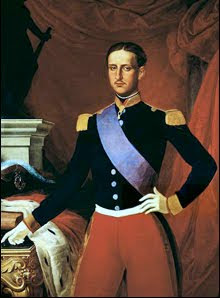By Lucian
Naples is a very old place and has many legends and spirits associated with it. Of the two most famous spirits in Naples, the bella ‘Mbriana is certainly the more positive one. The other is Munaciello, a much darker and frightening entity that I intend to write about some time in the future. The two are often mentioned together when the topic of Neapolitan ghosts or spirits arises.
I have found the customs surrounding the bella ‘Mbriana to be more than just quaint, they seem to be similar to at least two different pagan Roman traditions and the more I thought about her, the deeper her meaning became.
Said to be a princess that became extremely distraught due to an unhappy love affair, she would wander the city like a lost soul. Her father, the King, would give anonymous gifts to the families of households that looked after her. Her spirit has become associated with the protection of the household, and good fortune is supposed to come to those who pay her respect.

The
bella ‘Mbriana only appears for an instant, as a reflection in a window or through a curtain swaying in a breeze. She is described as a beautiful young woman with a gentle face, and there is brightness about her. Her name derives from the Latin “Meridian;” the brightest hour of the day. This is significant because Southern Italians are referred to as
Meridionali, a word that has the same Latin origin and refers to the people of the midday sun. The gecko is supposed to have a connection to ‘Mbriana. The lizards are found all over Naples and Southern Italy. Neapolitans believe that they bring good luck.
 |
A gecko at the Villa Rufolo in Ravello (Photo by New York Scugnizzo)
|
The Bella ‘Mbriana is said to be very powerful, bestowing luck upon those within the home she has chosen and taking revenge on those who offend it. Some claim that she prefers not to be referred to directly, others invoke her name for luck. The legends say that when inside the home one should never complain about the house being too small or dark, or speak of moving to a different one; for ‘Mbriana may feel slighted and punish you for it. If such things are to be discussed, it is better to do it outside of the house.
‘Mbriana also loves order and cleanliness, so it is wise to complete household chores to avoid irritating her. In this respect she reminds me of my own mother, who was also the heart and protector of our own household.
In the past it was the custom to set an extra place and chair at the table for ‘Mbriana to come in and rest among the family. The practice of the empty chair was also part of the ancient Roman ritual of Parentalia, which took place from February 13th to the 22nd. The Roman celebration included remembering the importance of family, honoring their ancestors and visiting their tombs.
The Catholic Church adopted part of the tradition, but switched the focus from family to Saint Peter, and celebrated it on February 22nd, the last day of Parentalia. Another celebration of St. Peter existed and was held on January 18th, but in 1960 the church abolished it in favor of the February celebration. The event is now known as feast of the chair of St. Peter (cathedra). It is also called the Bishop’s chair. The symbolism of the empty chair appears in cultures around the world, but the most plausible connection to ‘Mbriana is pagan Rome’s Parentalia and its Christian counterpart, the chair of St. Peter.
‘Mbriana’s connection to the physical home, and her role as guardian is also reminiscent of the Lares Familiaris of Roman household worship. The observation of rituals and the taboos associated with her also bear a distinct similarity to this spirit among others in the ancient Roman household, and also the spirits of the field and the dead.
“Here it will be most relevant to try to draw a picture of the Lar familiaris, as he was generally conceived. He is the guardian of the house and is looked on as a kindly and benevolent spirit, who watches over the fortunes not only of the family, but of the whole household, including the servants, from generation to generation.” (From Phases in the Religion of Ancient Rome by Cyril Bailey, p51)
“The spirits of his house and his land and his own Genius were friendly powers, all of them of the greatest importance for his life and his work, and their claims were attended to with regularity and devotion… there was nothing to fear if they were carefully propitiated; and his daily life and comfort depended on this propriation… ” (From The Religious Experience of the Roman People, by W. Warde Fowler M.A., p.92)
“The normal conception of the 'spirits' in Roman animism would seem to be that of neutral powers, who might be hostile, if neglected, but, if they are duly placated and receive the offerings which they require, will be friendly and give the worshipper health and prosperity.” (From Phases in the Religion of Ancient Rome by Cyril Bailey, p40)
My description of ‘Mbriana as a benign spirit may seem in doubt when I discuss her penchant for punishment and revenge, but it must be remembered that the world of our ancestors was difficult and often brutal, and it still is. Unlike us, our ancestors were more likely to face its unpleasantness instead of hiding from it. The bella ‘Mbriana, like the legends in Greco-Roman mythology or the lessons from Aesops fables, teaches us something about ourselves and offers insight to human nature without censoring its more disturbing aspects.
It is clear that ‘Mbriana commands respect not only through benevolence but also through fear. People of today’s era will probably be appalled at the idea of modifying behavior through fear, but such ideas continue to permeate many aspects of our lives. It really is no different in modern times; we fear eternal damnation if we break the laws of God, and we fear imprisonment or execution if we break the laws of man. One can claim that it isn’t the same thing, but it clearly is. Fear of consequences has more to do with people’s behavior than their perceived morality. If you doubt that, just watch what people do when they think they can get away with something. Even if only a few people take the opportunity, it is enough to prove my point.
‘Mbriana was probably used as a threat to get children to do their chores, and she isn’t the first figure used in such a way. Throughout Europe there are tales of fairies and other characters who are also used for such encouragement, these are just a few: The Slavic Domovoi (a house spirit similar to ‘Mbriana), the terrifying Celtic hobgoblin Rawhead and Bloody Bones, and Krampus (Santa Claus’ assistant and the Germanic answer to his naughty list). Historical figures were also used; the name of Abu Tabela is invoked in Peshwar to this day for similar reasons, and while it is not in Europe, Abu himself was a Neapolitan.
 |
Domovoi
|
The lessons of ‘Mbriana might be reinforced with fear, but are still important to learn. Let’s examine how the different aspects of her presence influence the atmosphere within the household.
The concept of something always watching us, spiritual or otherwise, can be disconcerting, especially to someone like me who values privacy. However, acting as if something is watching has a significant effect on a person’s behavior, and while it can be stressful, the changes are not always negative. Laws and cultural niceties are more likely to be followed, and we are more careful of what we do, and how we do it. Even if something out of the ordinary is done, the person doing it is more likely to make it appear normal, and be less careless about it. These habits make it easier for people to survive and function in any society, especially repressive ones. Traditions that instill this type of caution and general awareness would be particularly valuable in conquered and exploited regions, such as Southern Italy after the Risorgimento.
‘Mbriana’s taboo about complaints and negativity concerning the house make it easier to have more productive conversations at home. Complaining can become habit forming, it is better to do something about a problem than complain about it endlessly. Those mentioning ‘Mbriana only indirectly are forced to act as though they were doing things for their own benefit instead of the spirit’s, encouraging them to actually feel this way. After work, I do my best to leave the stress from my day outside my door, and appreciate what I have at home. After all, if you can’t appreciate what you have, you won’t appreciate having more.
‘Mbriana likes a clean and orderly house; this is an incentive to keep the household clean and in good repair, promoting a healthier environment for everyone living in it.
‘Mbriana demands respect, just like parents and other figures of authority. Growing up with that concept in the household can help put life outside it in a more realistic perspective. I certainly don’t like everyone that I’ve had to answer to and disagree with many political leaders, but all of us have to answer to someone and we always will. There is always a hierarchy within any group, even if you disagree with it or are fighting to change it. Respect is part of this, and just recognizing that reality allows you to make better decisions.
Life isn’t easy, but it never was. Our ancestors came home after work just like we do, and struggled with similar problems. Spirits like “Mbriana and her predecessors are projections of our own needs, and give people a reason to behave in their own best interests, even when they don’t feel like it. Whether or not you leave an empty chair for the bella ‘Mbriana, it is worthwhile to consider the lessons that she gives us.
References:
Managing Existence In Naples: Morality, action and structure, by Italo Pardo, published 1996, ISBN 0-521-56227-9 hardback, ISBN 0-521-56665-7 paperback
The religious experience of the Roman People, by W. Warde Fowler M.A. published 1911, reprinted 1971. ISBN 0-8154-0372-0.
Phases in the Religion of Ancient Rome by Cyril Bailey, published 1932, reprinted 1972 ISBN 0-8371-4759-X
Church’s Liturgy by Michael Kunzler ISBN-10 0826413528
The Genius of the Roman Rite: On the Reception and Implementation of the New Missal by Keith F. Pecklers ISBN-10 0814660215







































